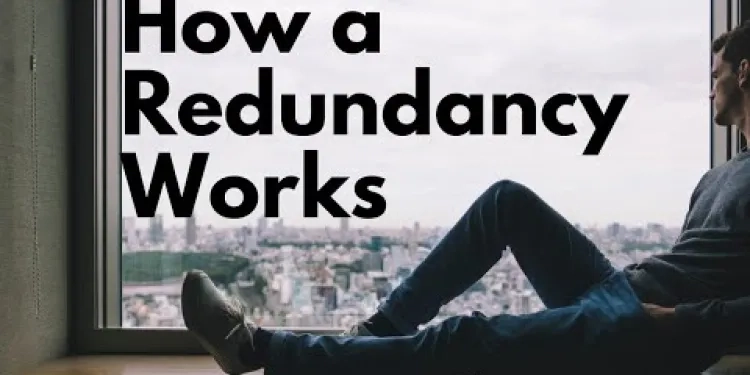Important Information On Using This Service
- Ergsy carefully checks the information in the videos we provide here.
- Videos shown by YouTube after a video has completed have NOT been reviewed by ERGSY.
- To view, click the arrow in the center of the video.
Using Subtitles and Closed Captions
- Most of the videos you find here will have subtitles and/or closed captions available.
- You may need to turn these on and choose your preferred language.
Turn Captions On or Off
- Go to the video you'd like to watch.
- If closed captions (CC) are available, settings will be visible on the bottom right of the video player.
- To turn on captions, click settings.
- To turn off captions, click settings again.
Find A Professional
Why Feedback in the workplace is important in redundancy.
Feedback in the workplace is a fundamental aspect of professional growth and organizational development. It serves as a valuable tool for both employees and employers. Constructive feedback provides individuals with insights into their strengths and areas for improvement, fostering continuous learning. Timely and specific feedback enhances performance, allowing employees to align their efforts with organizational goals.
Additionally, a culture that encourages open and honest feedback promotes effective communication and teamwork. It builds trust among team members and helps in resolving conflicts constructively. Managers play a pivotal role in providing guidance, recognizing achievements, and addressing challenges. Conversely, employees should be open to receiving feedback, viewing it as an opportunity for personal and professional development. Ultimately, a feedback-rich environment contributes to a positive workplace culture, driving innovation, collaboration, and overall success.
Listening to feedback can be very helpful in identifying the strengths that will help you find your next role.
Redundancy Coaching Couch 5: Redundancy and Feedback
Understanding Redundancy
In the United Kingdom, redundancy refers to the dismissal of employees when their roles are no longer necessary. This can happen due to various reasons such as company restructures, technological changes, or economic downturns. Redundancy is a stressful experience; hence, it's crucial to handle the situation with sensitivity and support.
The Importance of Feedback during Redundancy
Feedback, especially in the context of redundancy, serves multiple purposes. Constructive feedback helps in personal development, guiding the affected employees towards future opportunities and roles. It can boost their confidence and provide clarity on their strengths and areas for improvement.
Providing Effective Feedback
Feedback during redundancy must be structured, empathetic, and constructive. It is not just about pointing out weaknesses; it is about offering guidance for future employment. Here are a few tips for providing effective feedback:
- Be Honest but Compassionate: Clearly communicate the reasons behind the redundancy, ensuring that the employees understand it is not a reflection on their capabilities.
- Focus on Strengths: Highlight the strengths and achievements of the employees, encouraging them to leverage these in their job search.
- Offer Practical Advice: Provide advice on improving CVs, enhancing interview skills, and developing professional networks.
Support Systems for Redundant Employees
Support systems play a crucial role in helping redundant employees transition smoothly. Outplacement services, career counseling, and training programs are some avenues that can assist in developing new skills and securing new employment. Employers are encouraged to provide access to these resources to mitigate the impact of redundancy.
Legal Requirements and Fair Treatment
In the UK, employers must follow specific legal requirements when conducting redundancies. This includes providing adequate notice, offering redundancy pay, and ensuring fair selection criteria. Treating employees with respect and fairness during this process is paramount to upholding the company’s reputation and employee relations.
Mental Health and Well-being
The psychological impact of redundancy can be significant. Providing mental health support, such as access to counseling services, can make a considerable difference. Employers should promote a supportive environment where employees feel valued and heard, even during challenging times.
Conclusion
Redundancy and feedback are intertwined, serving as crucial elements in the transition process for affected employees. By offering empathetic, constructive feedback and robust support systems, employers can help their employees navigate redundancy with resilience and confidence.
Why Feedback at Work Matters During Redundancy
Feedback at work is very important. It helps people grow and learn. Feedback is good for both workers and bosses. It tells you what you are good at and what you need to get better at. This makes you learn all the time. When feedback is given quickly, it helps you do a better job. It also helps you work towards what the company wants.
When people share feedback openly, it makes talking and working together easier. It helps everyone trust each other and fix problems in a good way. Bosses need to guide their teams, say “well done” when things go right, and help solve problems. Workers should listen to feedback and use it to grow both personally and in their jobs. Good feedback makes work a happy place. It helps everyone to think of new ideas and work well together to succeed.
Listening to feedback is also helpful. It can show you what you are good at, which can help you when looking for a new job.
Redundancy Coaching Couch 5: Redundancy and Feedback
What is Redundancy?
In the United Kingdom, redundancy happens when someone loses their job because it is no longer needed. This can happen if a company changes, new technology comes in, or money is tight. Losing a job can be very difficult, so it's important to be kind and helpful.
Why Feedback is Important during Redundancy
Feedback means telling someone what they are good at and what they can do better. When someone loses their job, feedback can help them grow and find new work. It makes them feel good about themselves and shows what they can do.
How to Give Good Feedback
When a person loses their job, feedback should be clear, kind, and helpful. It's not just about saying what's wrong. It's about helping them find new work by:
- Being Honest and Kind: Explain why the job is ending. Make sure they know it’s not because they did a bad job.
- Talking About Strengths: Tell them what they are good at. This will help them when they look for new jobs.
- Giving Useful Tips: Help them write a better CV, practice for interviews, and make new work friends.
Helping People Who Lose Their Jobs
Help is very important if someone loses their job. Things like job advice, career talks, or learning new skills can help them find a new job. Employers should offer these to help people quickly move to new opportunities.
Rules and Fairness
In the UK, there are rules about how to end a job. Employers must warn people, pay redundancy money, and be fair in choosing who goes. It’s very important to be fair and respectful to keep a good company name and relationships.
Mental Health and Feeling Good
Losing a job can be very upsetting. It helps to talk to someone who can listen, like a counselor. Employers should make sure people feel supported and heard, even when times are tough.
Conclusion
When a job ends, feedback and help are very important. By being kind and helpful, employers can make it easier for people to find new jobs and stay strong and positive.
Frequently Asked Questions
What is redundancy?
Redundancy is a form of dismissal from your job, caused by your employer needing to reduce the workforce. This can happen due to various reasons such as budget cuts, restructuring of the company, or closure of the business.
What are my rights if I am made redundant?
You have several rights, including the right to a redundancy payment, a notice period, the option to move into a different role if available, and the right to consultation. You may also be eligible for time off to look for new work.
How is redundancy pay calculated?
Redundancy pay is usually based on your age, weekly pay, and the number of years you have worked for your employer. Statutory redundancy pay follows a specific formula, but some employers may offer enhanced redundancy packages.
What is the statutory notice period for redundancy?
You must be given a minimum notice period based on how long you have worked for your employer. For example, 1 week if you have been employed for 1 month to 2 years, and 1 week for every year employed if over 2 years, up to a maximum of 12 weeks.
Can I challenge a redundancy decision?
Yes, if you believe the redundancy is unfair, you can challenge it. You might want to seek legal advice or contact organisations such as ACAS for guidance.
What support is available during redundancy?
Support can include career coaching, outplacement services, and access to job search resources. Additionally, the Jobcentre Plus Rapid Response Service can provide practical help.
Can I be made redundant while on maternity leave?
Yes, but the reasons must be fair and your employer must follow proper procedures. You have additional protections and should be offered a suitable alternative position if available.
What feedback should I expect during the redundancy process?
You should receive clear communication and feedback from your employer regarding the reasons for redundancy, how it affects your role, and details about the redundancy process and any support available.
What should I do if I get made redundant?
Stay informed about your rights, seek legal advice if needed, update your CV, and start looking for new job opportunities. Use resources like career coaching and job search platforms to aid your transition.
How can I cope with the emotional impact of redundancy?
Acknowledge your feelings and seek support from friends, family, or professional counsellors. Keeping a positive mindset and focusing on future opportunities can also help.
What criteria should redundancy selection be based on?
Criteria can include skills, qualifications, work performance, and experience. Selection should not be based on discriminatory factors such as age, gender, disability, or race.
Am I entitled to paid time off to look for work?
If you have been continuously employed for at least 2 years, you are entitled to reasonable time off with pay during your notice period to look for another job or arrange training.
What is a collective redundancy?
Collective redundancy occurs when 20 or more employees are made redundant at one establishment within a 90-day period. Employers must follow additional consultation procedures in such cases.
How can redundancy affect my pension?
Redundancy might impact your pension contributions, particularly if you are part of a company pension scheme. You should receive information from your employer about how your pension will be affected.
Can I volunteer for redundancy?
Yes, some employers offer voluntary redundancy as an option. If you volunteer, you may receive a financial package that is usually at least the same as the statutory redundancy pay.
What is redundancy?
Redundancy means losing your job because there are too many workers and not enough work. It is not because you did something wrong.
Helpful Tips:
- Talk to someone if you feel upset.
- Look for help to find a new job.
- Make a list of what you are good at.
Redundancy is when you lose your job because your boss needs to have fewer workers. This can happen if the company needs to save money, changes how it works, or closes down.
What are my rights if I lose my job because it is not needed anymore?
If your job is not needed, it is called redundancy. Here is what you need to know:
- You should get a notice period. This is time to get ready to leave your job.
- You may get redundancy pay. This is money you get when your job is over.
- You can ask why your job is ending. This helps you understand the reason.
- You might get help finding a new job. Sometimes, your company can help you look for work.
- You can talk to someone if you are upset or confused. Friends, family, or a work helper can support you.
You have rights if you lose your job because it is not needed anymore. Make sure to ask questions and get help if you need it.
You have some important rights at work:
- You can get money if you lose your job.
- You should be told early if you might lose your job.
- If there is another job you can do, you should be told.
- You can talk to your boss about what is happening.
- You might be able to take some time off to find a new job.
It can help to ask someone you trust for advice.
How do you work out redundancy pay?
If you lose your job because it is no longer needed, you might get some money. This is called redundancy pay.
To work out how much you get:
1. Count how many full years you worked at the job.
2. Check how old you are.
3. Use the rules for calculating redundancy pay (ask an adult to help or use an online calculator).
Helpful tools:
- Ask an adult for help.
- Use an online calculator to make it easier.
- Write notes to keep track of what you find out.
Getting money when you lose your job is called redundancy pay. This money depends on three things: how old you are, how much you earn each week, and how many years you have worked for your boss.
There is a special way the government says to calculate this money, but some bosses might give you more.
What is the notice period if you lose your job?
How long will your boss tell you before you lose your job?
If your company lets you go, they must let you know before. The time they give you is called a "notice period."
Here are some tools to help you understand: - Break the information into small parts. - Use pictures or drawings to explain steps. - Ask a friend or family member to explain it to you.
You should get a notice period when you stop working. This depends on how long you have worked for your boss. If you have worked for 1 month to 2 years, you get 1 week of notice. If you worked for more than 2 years, you get 1 week for every year you worked. The most notice you can get is 12 weeks.
Tips and tools: Use a calendar to count the number of weeks. You can also ask someone you trust to help you understand these rules. If you have a phone or tablet, you can set reminders to keep track of important dates.
Can I ask for a change if I lose my job?
If you lose your job because of redundancy, you can ask for a change. This means you can say you do not agree. Here are some tips to help:
- Ask Why: Talk to your boss and ask why you are losing your job.
- Ask for Help: You can talk to a union or someone who knows about job laws.
- Write a Letter: You can write a letter to say you do not agree.
- Use Tools: There are websites and phone lines that can give advice.
Yes, if you think losing your job is not fair, you can say something about it. You might want to talk to a lawyer or get help from places like ACAS.
What help can you get if you lose your job?
If you lose your job, you can get help.
Here are some ways you can get help:
- Ask someone to help you write your CV. A CV is a list of your skills and jobs.
- Look for jobs online. You can use websites or apps.
- Talk to a job coach. They can give you advice.
- See if you can get money help. This is called benefits.
- Join groups that help people find jobs.
If you need help, ask someone you trust.
There are different ways to help people find a job. This help can include talking with a career coach, getting help when leaving a job, and using tools to look for a new job. The Jobcentre Plus Rapid Response Service can also give useful help.
Can I lose my job while on maternity leave?
Yes, your boss can move you, but it must be fair. They also need to follow the right steps. You have extra protection, and if there is another job that fits you, they should offer it to you.
What will people tell me during the redundancy process?
When you are going through redundancy, you will get some information and help. Here is what you can expect:
- Someone might talk to you and explain why the redundancy is happening.
- You should ask questions if anything is unclear. It's okay to ask and get help.
- You might have meetings with your boss or a manager. They will talk with you about your job.
- They may give you written information, like letters or emails, about what will happen next.
If you need more help, you can talk to a friend, family member, or a union representative. You can also use tools like a recorder to remember what people say, or a calendar to keep track of important dates.
Your boss should tell you clearly why your job is ending. They should explain how this affects your job, what will happen next, and if there is any help available for you.
What should I do if I lose my job?
If you lose your job, it's important to stay calm and take some steps to help yourself:
- Ask for help: Talk to family or friends who can support you.
- Check your money: Look at how much money you have saved. See if you can get any financial help.
- Make a plan: Think about what kind of job you want next. Write down steps to find a new job.
- Update your CV: Make sure your CV is up to date with all your latest skills and jobs.
- Learn new skills: Look for free classes or online courses to learn something new.
- Talk to others: Tell people you know that you are looking for a job. They might know of jobs for you.
Remember, it's okay to ask for help. You are not alone. You can talk to a counselor or job advisor for more support. They are there to help you.
Learn about what you can do, talk to a lawyer if you need help, make sure your CV is up to date, and start looking for new jobs. Get help from career coaches and use job websites to make finding a new job easier.
How can I feel better if I lose my job?
Losing your job can be tough. Here are some ways to help you feel better:
- Talk to friends and family. Sharing your feelings can help.
- Write about your feelings in a diary. This can make you feel lighter.
- Make a plan for the day. A routine can make things easier.
- Try to learn something new. This can keep your mind active.
- Ask for help if you need it. Talking to a counselor can be a good idea.
Remember, it's okay to feel sad or worried. Be kind to yourself.
It is important to know how you feel and talk about it. You can chat with friends, family, or a special helper like a counselor. Try to think good thoughts and look forward to new chances. This can make you feel better.
What things should be looked at when choosing who to let go from a job?
When choosing someone, think about what they can do, their training, how well they do their job, and what they have done before. Do not pick someone because of their age, if they are a boy or girl, if they have a disability, or the color of their skin.
To help read better, try using text-to-speech tools or apps that can read words out loud. You can also use highlighters to mark important words.
Can I get paid time off to find a new job?
If you have been working for the same place for 2 years or more, you can take some time off with pay to find a new job or get training. This happens during your notice period.
What is a collective redundancy?
When many people lose their jobs at the same time, we call it a "collective redundancy." It means a company needs fewer workers and has to let a lot of people go. It's like when a company says, "We don't need this many helpers anymore."
If you want help understanding this, you can talk to someone you trust. You can also use tools like drawing pictures or making lists to see how many workers are staying or leaving. These tools can help make the information clearer.
Collective redundancy happens when 20 or more workers lose their jobs at the same place in 90 days. Bosses have to talk to the workers and follow special rules when this happens.
How does losing my job affect my pension money?
When you lose a job, it's called redundancy. It might change how much money you get when you are older.
Here are some helpful tips:
- Talk to someone in your workplace or a money advisor.
- Look at your pension papers to see what they say.
- Use a calculator online to see how changes affect your money.
These steps can help you understand what happens to your future money if you lose your job.
If you lose your job because the company doesn't need you anymore, it might change how you save money for your pension. A pension is money you save now to use when you are older and don't work anymore. If your company helps you save money in a special plan, they will tell you how losing your job changes that.
Can I choose to leave my job and get money?
If you want to stop working and get money from your job, tell your boss. This is called "volunteering for redundancy." Here’s how you can do it:
- Ask your boss if you can choose to leave your job and get money.
- Your boss will tell you if it's okay to do this.
- It's important to check how much money you will get.
For extra help, you can:
- Talk to someone who knows a lot about jobs.
- Use easy online guides to understand more about leaving your job and getting money.
Yes, some bosses let people choose to leave their jobs. This is called voluntary redundancy. If you choose to leave, you might get some money. This money is often the same or more than the usual pay people get when they have to leave their job.
Useful Links
Useful links from: HOW A REDUNDANCY WORKS - General Information
- NHS - Redundancy This NHS page provides information on how redundancy can affect mental health and offers advice on coping strategies and support services.
- Citizen's Advice - Redundancy Citizen's Advice offers comprehensive information on redundancy, including rights, redundancy pay, notice periods, and where to get further help.
- Acas - Redundancy Handling Acas provides detailed guidance on redundancy processes, including legal requirements, proper consultations, and handling redundancies fairly.
- Mind - Mental Health and Redundancy Mind, a leading mental health charity in the UK, offers advice on coping with the emotional impact of redundancy and where to find further support.
Useful links from: Redundancy Crusader and Annabel Kaye on making redundancy a better experience (2).MTS
- Redundancy Crusader - Support for Redundancy Redundancy Crusader provides practical guidance and resources to help individuals navigate through redundancy, including legal advice and emotional support.
- Annabel Kaye - Employment Law Specialist Annabel Kaye offers expertise in employment law and works to make redundancy processes more humane and legally compliant for both employers and employees.
- Mind - Mental Health Support Mind is a UK-based charity that offers support and information to help those experiencing mental health issues, including difficulties arising from redundancy.
- NHS - Redundancy and Mental Health The NHS provides resources and advice on coping with the mental health impacts of redundancy, helping individuals manage stress and anxiety.
Useful links from: Redundancy Coaching Couch 2: Redundancy and Passion
- NHS Live Well - Redundancy The NHS Live Well page offers advice on redundancy and its impact on mental health, along with tips for managing stress and staying healthy.
- Mind - Money and Mental Health Mind, a mental health charity, provides resources and guidance on managing the emotional and psychological aspects of financial worries, including those stemming from redundancy.
- Citizens Advice - Redundancy Citizens Advice offers comprehensive information on redundancy rights, processes, and the support available to individuals facing redundancy.
- Samaritans - Whatever you're going through, call us free any time Samaritans provides confidential emotional support for people who are experiencing feelings of distress or despair, including those affected by redundancy.
Useful links from: Redundancy Coaching Couch 4:Redundancy and Language
- NHS - Coping with Redundancy NHS resource on managing and coping with the stress and emotional impact of redundancy.
- Mind - Redundancy Mind charity provides information and support for maintaining your mental health if you’re facing redundancy.
- Citizens Advice - Redundancy Citizens Advice offers practical guidance and advice on redundancy rights and what to do after being made redundant.
- Rethink Mental Illness - Redundancy Rethink Mental Illness provides advice on dealing with redundancy and unemployment, focusing on mental health support.
Useful links from: Redundancy Crusader and Annabel Kaye on scope and scale of redundancy (3).MTS
- Redundancy Crusader - Understanding Redundancies This site provides comprehensive information on the causes and management of redundancies, including legal requirements and best practices.
- Annabel Kaye - Employment Law Specialist Annabel Kaye offers expert advice on employment law, including redundancy processes and policies within the UK.
- NHS Employers - Redundancy and Redeployment NHS Employers provides guidelines and support regarding redundancy and redeployment within the NHS, covering legal aspects and employee support.
- NCVO - Managing Redundancies in Charities The National Council for Voluntary Organisations (NCVO) offers resources and advice on handling redundancies in UK-based charities, ensuring legal compliance and best practices.
Useful links from: Redundancy Coaching Couch 7: Redundancy and Judgement.MTS
- NHS - Coping with Redundancy Learn how to manage and cope with redundancy and its impacts on mental health. This page provides practical steps and resources to help you deal with the changes and emotions that come with job loss.
- Mind - Work Issues Mind, the mental health charity, offers support and advice on dealing with work-related issues including redundancy. They provide various resources and information to help maintain mental well-being during challenging times.
- Samaritans - Job Loss and Financial Worries Samaritans provide emotional support to anyone in distress or struggling to cope, including those facing job loss and financial concerns. Access their services for confidential support and guidance.
- Rethink Mental Illness - Stress at Work Rethink Mental Illness offers information and resources to help manage stress at work and addresses related mental health issues. Find practical advice for coping with redundancy and maintaining your mental health.
Useful links from: Redundancy Crusader and Annabel Kaye on the Current Model of Redundancy (1).MTS
- Redundancy Crusader Redundancy Crusader offers comprehensive support and advice for individuals facing redundancy, including resources for understanding your rights and navigating the redundancy process in the UK.
- Annabel Kaye's Official Website Annabel Kaye is an employment law specialist. Her website provides insights into the current model of redundancy, legal advice, and HR policy updates tailored for UK-based employers and employees.
- NHS - Your Rights at Work The NHS provides essential information on employee rights, including those facing redundancy, focusing on health sector employees but also relevant across other sectors.
- Citizens Advice - Redundancy Citizens Advice offers detailed guidance on redundancy rights, processes, and benefits, tailored for people living in the UK. It includes practical advice on how to deal with redundancy and where to seek further help.
Useful links from: Redundancy Crusader and Annabel Kaye on communications in redundancy (5).MTS
- Redundancy Crusader Redundancy Crusader offers resources and support for professionals facing redundancy. It includes guidance on updating CVs, preparing for interviews, and managing the emotional impact of redundancy.
- NHS - Coping with Redundancy The NHS provides advice on dealing with stress and mental health concerns related to redundancy. It covers practical steps to manage change, seek emotional support, and maintain physical health.
- Mind - Redundancy Mind, a UK-based mental health charity, offers comprehensive advice on handling the psychological impact of redundancy. The site includes coping strategies, financial advice, and resources for finding new work.
- Annabel Kaye - LinkedIn Annabel Kaye is a speaker and consultant with experience in employment law and redundancy issues. Her LinkedIn profile provides insights into her expertise and useful posts on managing redundancy.
Useful links from: Redundancy Coaching Couch 1: Redundancy and Presuppositions
- NHS - Redundancy and mental health NHS resource providing information on the mental health impacts of redundancy, including coping strategies and where to find support.
- Mind - Redundancy UK mental health charity Mind offers advice and support on handling the emotional and psychological effects of redundancy.
- Citizens Advice - Redundancy Citizens Advice provides guidance on the practical aspects of redundancy, including rights, processes, and financial entitlements.
- Samaritans - Help and Support Samaritans offers emotional support for anyone going through a difficult time, including those affected by redundancy, through a helpline and other resources.
Useful links from: Redundancy Coaching Couch 3: States
- NHS - Redundancy The NHS provides resources and advice on coping with redundancy, including information on how to manage stress and where to find additional support.
- Citizens Advice Citizens Advice offers guidance on your rights during redundancy, what your employer has to pay, and how to cope with the emotional and financial impact.
- Mind - Redundancy and Mental Health Mind, a UK-based mental health charity, provides practical advice and support for those dealing with redundancy and its effects on mental well-being.
- Turn2us Turn2us is a national charity that offers information on benefits, grants, and financial assistance available to those experiencing redundancy.
Useful links from: Frequently asked questions about redundancy from ACAS
- ACAS - Redundancy: your rights ACAS provides comprehensive guidance on employee rights during redundancy, including the process, notice periods, and redundancy pay.
- NHS Employers - Redundancy Information NHS Employers offer detailed information on redundancy, tailored specifically for NHS staff, covering statutory rights and support mechanisms.
- Macmillan Cancer Support - Redundancy and Cancer Macmillan Cancer Support provides resources for individuals facing redundancy while dealing with cancer, including emotional and financial guidance.
- Citizens Advice - Redundancy Overview Citizens Advice offers an extensive overview of redundancy, explaining your rights, redundancy pay, and the steps to take if you face redundancy.
Useful links from: Understanding the Impact of Rising Living Costs on Family Welfare
- NHS - Help with Health Costs The NHS provides information on various schemes and benefits available to help people manage rising health-related costs. This includes prescriptions, dental care, eye care, and travel costs.
- Citizens Advice - Cost of Living Support Citizens Advice offers guidance on managing the rising cost of living, including help with bills, benefits, and financial support. This resource can help families understand their entitlements and find support services.
- The Trussell Trust - Find a Foodbank The Trussell Trust works to stop UK hunger and poverty. They provide access to local food banks for those in need, helping families who are struggling with the increased cost of living.
- Turn2us - Benefits Calculator Turn2us offers a comprehensive benefits calculator to help individuals and families determine which state benefits and grants they may be entitled to amidst rising living costs.
More Videos of Interestdiagnosis
- Ergsy carfully checks the information in the videos we provide here.
- Videos shown by Youtube after a video has completed, have NOT been reviewed by ERGSY.
- To view, click the arrow in centre of video.
- Most of the videos you find here will have subtitles and/or closed captions available.
- You may need to turn these on, and choose your preferred language.
- Go to the video you'd like to watch.
- If closed captions (CC) are available, settings will be visible on the bottom right of the video player.
- To turn on Captions, click settings .
- To turn off Captions, click settings again.











